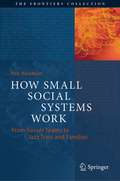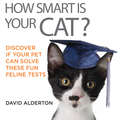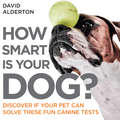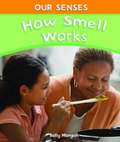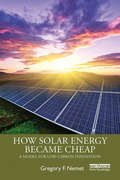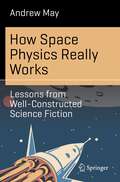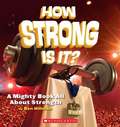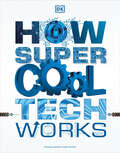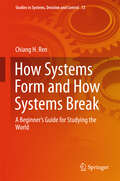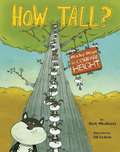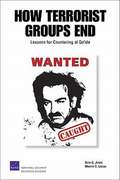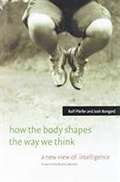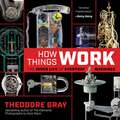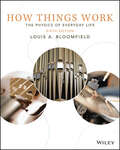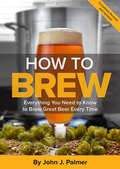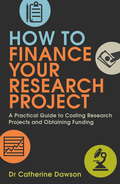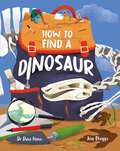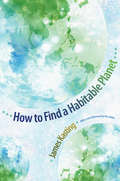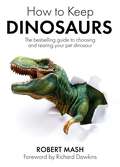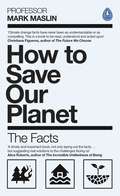- Table View
- List View
How Small Social Systems Work: From Soccer Teams to Jazz Trios and Families (The Frontiers Collection)
by Yair NeumanMost of us are intuitively familiar with small social systems, such as families and soccer teams. Surprisingly, though, most of us are unaware of how complex these systems are or of the fact that they have a unique character distinguishing them from both populations and individuals. The current manuscript, which emerged from high-level scientific publications on the subject, aims to bridge this gap in our understanding of small social systems. The book aims to explain, illustrate, and model the unique and fascinating nature of small (social) systems by relying on deep scientific foundations and by using examples from sport, movies, music, and the martial arts. To support its friendly exposition of challenging scientific ideas, the book also discusses entertaining questions such as (1) why inviting your mother-in-law to dinner might be a challenging event, for reasons you have never considered; (2) why soccer teams should be messy in order to win; (3) why Nazis are deeply wrong in their understanding of the importance of entropy; and (4) why “panda fighters” failed in the UFC (Ultimate Fighting Championship)."How Small Systems Work is a welcome book, which sheds light on a branch of mathematics overlooked by scholars: how networks store information. Focusing on small systems, the book asks fundamental questions, providing the tools (and the examples) for answering them –with fun. Neuman analyses, with plenty of humor, the dynamics of a family of cats, the pleasure of listening to jazz, and the science behind football championships, while uncovering hidden gems in the history of cinema”Dr. Mario Alemi, author of “The Amazing Journey of Reason: from DNA to Artificial Intelligence”
How Smart Is Your Cat?
by David AldertonWe all wonder how much our pet understands, what is going on in their head and just how intelligent they really are. This entertaining and comprehensive guide will not only explain your cat's sometimes baffling behavior--it will give you the means to test your pet's IQ yourself.Using your cat's natural skills, How Smart Is Your Cat? will enable you to improve their responses and reactions--and ultimately their IQ--as you work through a wealth of intelligence tests, giving them a star rating as they progress. The bond between you will deepen as you learn more about how your cat thinks.Featuring panels on feline psychology, different cat breeds and information on how cats communicate, How Smart Is Your Cat? is the ideal companion for everyone who wants to understand what their cat is thinking and how to communicate with them effectively.The perfect gift for cat lovers everywhere, this book will open your eyes to just how canny your kitten can be!
How Smart Is Your Dog?
by David AldertonPacked with a wealth of fun tests and easy-to-teach exercises, this comprehensive guide will allow you to test your dog's IQ, communicate with them more effectively and teach them tricks that will impress your friends and family.Using your dog's natural skills, How Smart Is Your Dog? will enable you to teach them tricks like 'shake hands', 'fetch a ball', 'play dead' and 'salute'. A star rating system enables you to assess your pet's IQ as they progress through the tests and tricks. The bond between you will deepen as your dog learns to respond to your instructions and enjoys the reward that awaits them at the end.Featuring panels on canine psychology, different dog breeds, information on how animals learn and the best way to teach them, How Smart Is Your Dog? is the ideal companion to your training. From basic obedience skills for your puppy to advanced agility routines, your pet will have fun learning--and hopefully you will too.The perfect gift for dog lovers everywhere, this book will open your eyes to just how smart your pooch can be!
How Smell Works (Our Senses)
by Sally MorganWhy do some things smell good and other things smell bad? This book explains where our sense of smell comes from and how it helps us function in everyday life. A lively, straightforward narrative presents scientific concepts for young readers and an activity is included enhance the learning experience.
How Societies Remember
by Paul ConnertonIn treating memory as a cultural rather than an individual faculty, this book provides an account of how bodily practices are transmitted in, and as, traditions. Most studies of memory as a cultural faculty focus on written, or inscribed transmissions of memories. Paul Connerton, on the other hand, concentrates on bodily (or incorporated) practices, and so questions the currently dominant idea that literary texts may be taken as a metaphor for social practices generally. The author argues that images of the past and recollected knowledge of the past are conveyed and sustained by ritual performances and that performative memory is bodily. Bodily social memory is an essential aspect of social memory, but it is an aspect which has until now been badly neglected. An innovative study, this work should be of interest to researchers into social, political and anthropological thought as well as to graduate and undergraduate students.
How Solar Energy Became Cheap: A Model for Low-Carbon Innovation
by Gregory F. NemetSolar energy is a substantial global industry, one that has generated trade disputes among superpowers, threatened the solvency of large energy companies, and prompted serious reconsideration of electric utility regulation rooted in the 1930s. One of the biggest payoffs from solar’s success is not the clean inexpensive electricity it can produce, but the lessons it provides for innovation in other technologies needed to address climate change. Despite the large literature on solar, including analyses of increasingly detailed datasets, the question as to how solar became inexpensive and why it took so long still remains unanswered. Drawing on developments in the US, Japan, Germany, Australia, and China, this book provides a truly comprehensive and international explanation for how solar has become inexpensive. Understanding the reasons for solar’s success enables us to take full advantage of solar’s potential. It can also teach us how to support other low-carbon technologies with analogous properties, including small modular nuclear reactors and direct air capture. However, the urgency of addressing climate change means that a key challenge in applying the solar model is in finding ways to speed up innovation. Offering suggestions and policy recommendations for accelerated innovation is another key contribution of this book. This book will be of great interest to students and scholars of energy technology and innovation, climate change and energy analysis and policy, as well as practitioners and policymakers working in the existing and emerging energy industries.
How Space Physics Really Works: Lessons from Well-Constructed Science Fiction (Science and Fiction)
by Andrew MayThere is a huge gulf between the real physics of space travel and the way it is commonly portrayed in movies and TV shows. That’s not because space physics is difficult or obscure – most of the details were understood by the end of the 18th century – but because it can often be bafflingly counter-intuitive for a general audience. The purpose of this book isn’t to criticize or debunk popular sci-fi depictions, which can be very entertaining, but to focus on how space physics really works. This is done with the aid of numerous practical illustrations taken from the works of serious science fiction authors – from Jules Verne and Arthur C. Clarke to Larry Niven and Andy Weir – who have taken positive pleasure in getting their scientific facts right.
How Space Works: The Facts Visually Explained (DK How Stuff Works)
by DKEmbark on an awe-inspiring and informative journey through our Solar System and beyond in this illuminating astronomy book! Discover how big the Universe is, why our view of the sky is constantly changing, what came before the Big Bang, and so much more in 3... 2... 1…. Blast Off! Inside the pages of this comprehensive guide to astronomy for beginners, you&’ll discover: • Simple text and step-by-step graphics that make astronomy easy to understand • Fun facts and tip-of-the-tongue questions are presented through bite-sized factoids and question-and-answer features • Clear explanations demystifying more advanced topics such as cosmic rays, dark matter, and black hole collisions Take a peek at what lies beyond the stratosphereThis out-of-this-world reference book about space introduces you to the weird and wonderful discipline of astronomy and space exploration. From the structure of the Milky Way to the Earth&’s nearest celestial body, the Moon, How Space Works takes you on an unforgettable tour through the stars and galaxies, and to the furthest reaches of space!Answering all your burning questions about space, from ancient white dwarf stars to the Mars Rover, this visual guide explains the essentials of astronomy through bold graphics and step-by-step artworks. It&’s the ultimate book for armchair astronomers and space-technology enthusiasts looking for reliable and up-to-date facts and explanations.Don&’t let the learning stop - try the rest of the series!DK's How Things Work series uses dynamic graphics and jargon-free text to explain the modern world simply and clearly. Packed with fascinating facts and stats, these visual guides cover everything from science to philosophy, making complex topics more accessible than ever before!
How Strong Is It?: A Mighty Book All About Strength
by Ben HillmanHOW STRONG IS IT? A Mighty Book All About Strength. How strong is a spiderweb? Spider silk is one of the most amazing materials found on the planet--natural or human-made. In fact, if each strand was as thick as a pencil, a spiderweb could stop a Boeing 747 in mid-flight!
How Super Cool Tech Works
by DKDiscover the mind-blowing high-tech inventions of the future! Incredible images reveal the secret inner workings of everything from drones and supercomputers to underwater hotels and flying cars.How Super Cool Tech Works explains how incredible technologies will shape the world of tomorrow. Explore robotics, space rockets, artificial intelligence, and even game consoles in this cutting-edge non-fiction science book for kids aged 9 and over. Also featured are state-of-the-art buildings, new ways of traveling, imaginative entertainment gadgets, and even how teleportation and invisibility cloaks might be possible in the future. Each exciting subject is explained in detail, via crisp images and engaging, child-friendly text. "How it works" panels explain each subject&’s secret inner workings.New and updated for 2020, How Super Cool Tech Works is a one-stop shop for kids who want to know what the latest and greatest technologies are, and how they will shape our world in the years to come.
How Systems Form and How Systems Break
by Chiang H. RenOur world is composed of systems within systems the machines we build, the information we share, the organizations we form, and elements of nature that surround us. Therefore, nearly every field of study and practice embodies behaviors stemming from system dynamics. Yet the study of systems has remained somewhat fragmented based on philosophies, methodologies, and intentions. Many methodologies for analyzing complex systems extend far beyond the traditional framework of deduction evaluation and may, thus, appear mysterious to the uninitiated. This book seeks to dispel the mysteries of systems analysis by holistically explaining the philosophies, methodologies, and intentions in the context of understanding how all types of systems in our world form and how these systems break. This presentation is made at the level of conceptual understanding, with plenty of figures but no mathematical formulas, for the beginning student and interested readers new to studying systems. Through the conceptual understanding provided, students are given a powerful capability to see the hidden behaviors and unexplained consequences in the world around us. "
How Tall?: Wacky Ways To Compare Height (Wacky Comparisons)
by Terry Flaherty Mark Weakland Advocate-Art Staff Igor SinkovecHow many chipmunks equals the height of a redwood tree? Discover this comparison and more in this wacky, laugh-out-loud introduction to height. Quirky illustrations and lyrical text help kids explore measureable attributes of a variety of things in a uniquely engaging way. A perfect read-aloud for young science lovers and budding mathematicians.
How Terrorist Groups End: Lessons for Countering Al Qa'ida
by Seth G. Jones Martin C. LibickiAll terrorist groups eventually end. But how do they end? The evidence since 1968 indicates that most groups have ended because (1) they joined the political process (43 percent) or (2) local police and intelligence agencies arrested or killed key members (40 percent). Military force has rarely been the primary reason for the end of terrorist groups, and few groups within this time frame have achieved victory. This has significant implications for dealing with al Qa'ida and suggests fundamentally rethinking post-9/11 U.S. counterterrorism strategy: Policymakers need to understand where to prioritize their efforts with limited resources and attention. The authors report that religious terrorist groups take longer to eliminate than other groups and rarely achieve their objectives. The largest groups achieve their goals more often and last longer than the smallest ones do. Finally, groups from upper-income countries are more likely to be left-wing or nationalist and less likely to have religion as their motivation. The authors conclude that policing and intelligence, rather than military force, should form the backbone of U.S. efforts against al Qa'ida. And U.S. policymakers should end the use of the phrase 'war on terrorism' since there is no battlefield solution to defeating al Qa'ida.
How The Body Shapes The Way We Think: A New View Of Intelligence
by Rolf Pfeifer Josh BongardHow could the body influence our thinking when it seems obvious that the brain controls the body? In How the Body Shapes the Way We Think, Rolf Pfeifer and Josh Bongard demonstrate that thought is not independent of the body but is tightly constrained, and at the same time enabled, by it. They argue that the kinds of thoughts we are capable of have their foundation in our embodiment--in our morphology and the material properties of our bodies. <P><P> This crucial notion of embodiment underlies fundamental changes in the field of artificial intelligence over the past two decades, and Pfeifer and Bongard use the basic methodology of artificial intelligence--"understanding by building"--to describe their insights. If we understand how to design and build intelligent systems, they reason, we will better understand intelligence in general. In accessible, nontechnical language, and using many examples, they introduce the basic concepts by building on recent developments in robotics, biology, neuroscience, and psychology to outline a possible theory of intelligence. They illustrate applications of such a theory in ubiquitous computing, business and management, and the psychology of human memory. Embodied intelligence, as described by Pfeifer and Bongard, has important implications for our understanding of both natural and artificial intelligence.
How Things Work: A Child's First Library of Learning
by The Editors at the Time-Life BooksQuestions and answers provide information about how cameras, elevators, car engines, tops, yo-yos, and other devices work. Includes charts, diagrams, and an activities section.
How Things Work: The Inner Life of Everyday Machines
by Theodore GrayMillion-copy bestselling author of The Elements, Molecules, and Reactions Theodore Gray applies his trademark mix of engaging stories, real-time experiments, and stunning photography to the inner workings of machines, big and small, revealing the extraordinary science, beauty, and rich history of everyday things. Theodore Gray has become a household name among fans, both young and old, of popular science and mechanics. He's an incorrigible tinkerer with a constant curiosity for how things work. Gray's readers love how he always brings the perfect combination of know-how, humor, and daring-do to every project or demonstration, be it scientific or mechanical. In How Things Work he explores the mechanical underpinnings of dozens of types of machines and mechanisms, from the cotton gin to the wristwatch to an industrial loom. Filled with stunning original photographs in Gray's inimitable style, How Things Work is a must-have exploration of stuff--large and small--for any builder, maker or lover of mechanical things.
How Things Work: The Physics of Everyday Life
by Louis A. BloomfieldHow Things Work provides an accessible introduction to physics for the non-science student. Like the previous editions it employs everyday objects, with which students are familiar, in case studies to explain the most essential physics concepts of day-to-day life. Lou Bloomfield takes seemingly highly complex devices and strips away the complexity to show how at their heart are simple physics ideas. Once these concepts are understood, they can be used to understand the behavior of many devices encountered in everyday life. The sixth edition uses the power of WileyPLUS Learning Space with Orion to give students the opportunity to actively practice the physics concepts presented in this edition.
How To Brew: Everything You Need to Know to Brew Great Beer Every Time
by John J. PalmerHow to Brew is the definitive guide to making quality beers at home. Whether you want simple, sure-fire instructions for making your first beer, or you&’re a seasoned homebrewer working with all-grain batches, this book has something for you. John Palmer adeptly covers the full range of brewing possibilities—accurately, clearly and simply. From ingredients and methods to recipes and equipment for brewing beer at home, How to Brew is loaded with valuable information on brewing techniques and recipe formulation.A perennial best seller since the release of the third edition in 2006, How to Brew, is a must-have to update every new and seasoned brewer&’s library.This completely revised and updated edition includes:More emphasis on the &“top six priorities&”: sanitation, fermentation temperature control, yeast management, the boil, good recipes, and water.Five new chapters covering malting and brewing, strong beers, fruit beers, sour beers, and adjusting water for style.All other chapters revised and expanded:Expanded and updated charts, graphs, equations, and visuals.Expanded information on using beer kits.Thorough revision of mashing and lautering chapters:Expanded tables of recommended times and temperatures for single-infusion, multiple-step, and decoction mashing.Complete discussion of first wort gravity as a function of water to grist ratio.Complete revision of infusion and decoction equations.Revised and updated information on managing your fermentation:Yeast pitching and starters. Yeast starter growth factors.Yeast and the maturation cycle.And much more!
How To Finance Your Research Project: A Practical Guide To Costing Research Projects And Obtaining Funding
by Catherine DawsonObtaining research funding can be a long, laborious and stressful process. This book helps ease this process by providing practical advice, useful tips and information about funding databases and funding directories. Covering a wide variety of funding sources such as government, industry and charity, it is suitable for researchers in the UK, US, EU and further afield. Learn how to: ? Find relevant sources of funding ? Produce and justify your budget ? Cost your project ? Complete and submit your application form ? Use ethical funding organizations ? Avoid conflict of interest
How To Finance Your Research Project: A Practical Guide to Costing Research Projects and Obtaining Funding
by Dr Catherine DawsonObtaining research funding can be a long, laborious and stressful process. This book helps ease this process by providing practical advice, useful tips and information about funding databases and funding directories. Covering a wide variety of funding sources such as government, industry and charity, it is suitable for researchers in the UK, US, EU and further afield.Learn how to:· Find relevant sources of funding· Produce and justify your budget· Cost your project· Complete and submit your application form· Use ethical funding organizations· Avoid conflict of interest
How To Find A Dinosaur
by Dr. Dave HoneDinosaurs went extinct 66 million years ago, but their fossils can still be found hidden beneath the earth - if you know how to look for them. Learn how to be a dinosaur detective and join a team at every stage of the process, from planning an expedition and digging for clues to safely transporting any finds back for study. Meet the palaeontologists and geologists who cross continents to uncover underground fossils and the researchers and palaeoartists who work out the stories from the bones.We're going on a dinosaur hunt... what will we find?Written by an expert palaeontologist with experience of discovering new species, each stage in the process is verified and a perfect resource for fossil hunters aged 7 and up.
How To Find A Habitable Planet (Science Essentials)
by James KastingTukufu Zuberi offers a concise account of the historical connections between the development of the idea of race and the birth of social statistics. Zuberi describes the ways race-differentiated data is misinterpreted in the social sciences and asks searching questions about the ways racial statistics are used. He argues that statistical analysis can and must be deracialized, and that this deracialization is essential to the goal of achieving social justice for all.
How To Keep Dinosaurs: The perfect mix of humour and science
by Robert Mash'Who could resist a handbook about potential pets that has a little symbol for "likes children" and a separate one for "likes children to eat"... wonderful' GUARDIANHollywood and the popular press would have us believe that all dinosaurs are gigantic, hostile and untameable. In fact, there are many species that make charming and even useful companions: Velociraptor - a splendid, loyal, fierce, friendDeinonychus - will not eat dog food (dogs are another matter)Tyrannosaurus - least suitable to keep; will need special licenceOrnithomimus - an appealing first dinosaur for the child anxious for her first rideThis book advises you which dinosaur is right for you and your home, from the city apartment dweller looking for a lap pet, to the country estate owner looking to tighten up on security. HOW TO KEEP DINOSAURS is a bestselling guide, packed with the sort of information keen dinosaur keepers crave - from feeding and housing to curing common ailments, breeding and showing your animal. The author, a zoologist with extensive experience of dinosaurs, has provided a timely and much-needed source book for all those who keep dinosaurs and for the huge numbers who are contemplating getting one. It is as essential to every dinosaur keeper as a stout shovel and a tranquilliser rifle.
How To Make Slime
by Lori ShoresWhat substance can act like both a solid and a liquid? Slime! Want to find out how to make your own? Just follow the simple steps inside this book
How To Save Our Planet: The Facts
by Mark A. Maslin'Punchy and to the point. No beating around the bush. This brilliant book contains all the information we need to have in our back pocket in order to move forward' Christiana Figueres, Former Executive Secretary UN Climate Change Convention'Amazing book' Chris Evans, Virgin Radio Breakfast Show'Everyone should have this book' Rick Edwards, BBC Radio 5 Live'A timely and important book, not only laying out the facts...but suggesting real solutions to the challenges facing us' Professor Alice Roberts, Anatomist, Professor of Public Engagement in Science, University of Birmingham_________________________ How can we save our planet and survive the 21st century? How can you argue with deniers? How can we create positive change in the midst of the climate crisis? Professor Mark Maslin has the key facts that we need to protect our future. Global awareness of climate change is growing rapidly. Science has proven that our planet and species are facing a massive environmental crisis. How to Save Our Planet is a call to action, guaranteed to equip everyone with the knowledge needed to make change. Be under no illusion the challenges of the twenty-first century are immense. We need to deal with: climate change, environmental destruction, global poverty and ensure everyone's security. We have the technology. We have the resources. We have the money. We have the scientists, the entrepreneurs and the innovators. We lack the politics and policies to make your vision of a better world happen. So we need a plan to save our planet... How to Save Our Planet is your handbook of how we together can save our precious planet. From the history of our planet and species, to the potential of individuals and our power to create a better future, Maslin inspires optimism in these bleak times. We stand at the precipice. The future of our planet is in our hands. It's time to face the facts and save our planet from, and for, ourselves._________________________'A handbook of clearly established, authoritative facts and figures about the terrible toll we as humans have taken of our planet, plus ways in which we can lessen the impact. For laypeople like me, who can see what is happening but haven't always got the precise statistics to hand, it's hugely valuable' John Simpson CBE, BBC World Affairs Editor, Broadcaster, Author & Columnist'Saving the world is no small thing, but picking up this book's a good start' Paris Lees, Contributing Editor at British Vogue, campaigner'I love it. My kids love it' Chris Evans, Virgin Radio Breakfast Show'A no-nonsense crib sheet on the state of the world and how to help it' The I Newspaper
